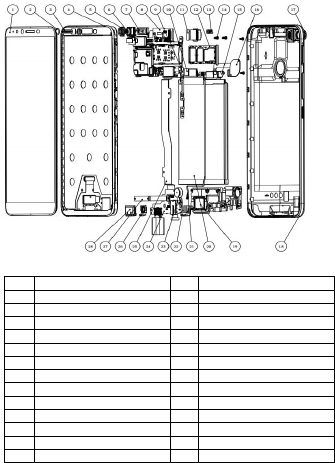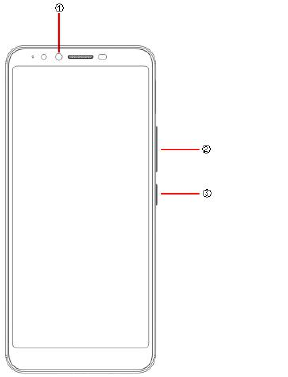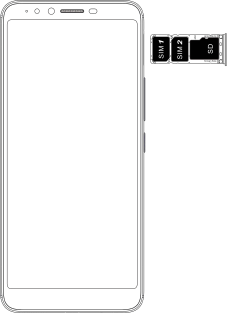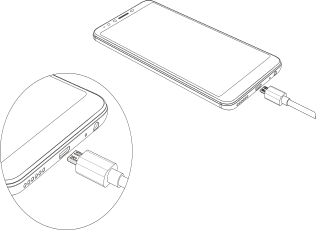TECNO MOBILE CA7 Mobile phone User Manual Sanjeev
TECNO MOBILE LIMITED Mobile phone Sanjeev
User Manual

1
Explosion
Explosion diagram
diagram specification
specification
1
CTP+LCM Assembly
2
Front camera seal foam
3
Receiver Decoration
4
Front Housing Assembly
5
Front camera rubber
6
Front camera
7
Receiver
8
Main PCBA
9
FPC side key
10
LCM junctor steel Assembly
11
Back camera
12
Card holder
13
Light sensation rubber
14
Screw
15
Battery junctor steel
16
Fingerchip Assembly
17
Cam lens
18
Battery cover Assembly
19
Speaker
20
Battery
21
Cable RF
22
Jack rubber
23
MOT FPC
24
SUB PCBA
25
Main link fpc
26
Mic rubber
27
FPC speaker
28
USB rubber

2
Know your phone
1. Front camera
2. Volume key
3. Power key
1

3
SIM/SD card installation
1. Power off mobile.
2. Refer to the following picture for SIM / SD card
installation.

4
Charging the phone
You can charge your device using a charger or by connecting
it to the computer using a USB cable (comes with the
phone).
1. Please remind the front and back of the plug.
2. Use only TECNO charger and cables. Other chargers or
cables may damage the device. This will invalidate your
phone warranty.
FCC Caution
Labelling requirements.
This device complies with part 15 of the FCC Rules. Operation is subject
to the condition that this device does not cause harmful interference.
Information to user.
Any changes or modifications not expressly approved by the party
responsible for compliance could void the user's authority to operate the
equipment.
Information to the user.
Note: This equipment has been tested and found to comply with the
limits for a Class B digital device, pursuant to part 15 of the FCC Rules.
These limits are designed to provide reasonable protection against
harmful interference in a residential installation. This equipment
generates uses and can radiate radio frequency energy and, if not
installed and used in accordance with the instructions, may cause
harmful interference to radio communications. However, there is no
guarantee that interference will not occur in a particular installation. If
this equipment does cause harmful interference to radio or television
reception, which can be determined by turning the equipment off and on,
the user is encouraged to try to correct the interference by one or more
of the following measures:
-Reorient or relocate the receiving antenna.
-Increase the separation between the equipment and receiver.
-Connect the equipment into an outlet on a circuit different from that to
which the receiver is connected.
-Consult the dealer or an experienced radio/TV technician for help.
Specific Absorption Rate (SAR) information:
This Mobile phone meets the government's requirements for exposure to
radio waves. The guidelines are based on standards that were developed
by independent scientific organizations through periodic and thorough
evaluation of scientific studies. The standards include a substantial safety
margin designed to assure the safety of all persons regardless of age or
health.
FCC RF Exposure Information and Statement The SAR limit of USA (FCC) is
1.6W/kg averaged over one gram of tissue. Device types: CA7FCC ID:
2ADYY-CA7) has also been tested against this SAR limit. The highest SAR
value reported under this standard during product certification for use at
the ear is 0.46W/kg and when properly worn on the body is 1.28W/kg.
This device was tested for typical body-worn operations with the back of
the handset kept 10mm from the body. To maintain compliance with FCC
RF exposure requirements, use accessories that maintain a 10mm
separation distance between the user's body and the back of the handset.
The use of belt clips, holsters and similar accessories should not contain
metallic components in its assembly. The use of accessories that does not
satisfy these requirements may not comply with FCC RF exposure
requirements, and should be avoided.
Body-worn Operation
This device was tested for typical body-worn operations. To comply with
RF exposure requirements, a minimum separation distance of 1.0 cm
must be maintained between the user’s body and the handset, including
the antenna. Third-party belt-clips, holsters, and similar accessories used
by this device should not contain any metallic components. Body-worn
accessories that do not meet these requirements may not comply with RF
exposure requirements and should be avoided. Use only the supplied or
an approved antenna.